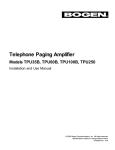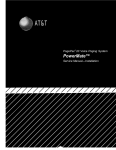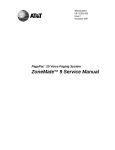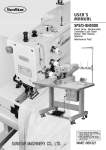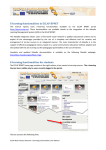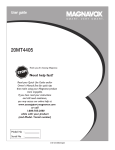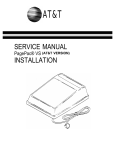Download Braun 604XC Mobility Aid User Manual
Transcript
AT&T 12/88 PagePac® 6 Voice Paging System User and Installation Manual PagePac 6 is recommended for the following telephone systems (some installations may require a separate adapter, see page 2). PAGEPAC® 6 COMPATIBILITY CHART TELEPHONE SYSTEM CONNECTION POINT AT&T TELEPHONE SYSTEM TELEPHONE (STATION) SIDE ACCESS CENTRAL OFFICE (LINE) SIDE ACCESS SPIRIT® 308/616 YES, Via Standard SPIRIT® 308/316 page port *YES, requires PagePac® option SPIRIT® 2448 Not offered by SPIRIT® 2448 *YES, requires PagePac® option YES, Via Standard MERLIN® PLUS page port *YES, requires PagePac® option Not offered by MERLIN® II *YES, requires PagePac® option YES, may require SYSTEM 25 hardware options *YES, requires PagePac® option MERLIN® PLUS MERLIN® II SYSTEM® 25 *See Pages 2, 4, and 6 for PagePac® options ORDERING INFORMATION PagePac 6—PEC 5323-006, COMCODE 405701277 PagePac 6 Port Saver—PEC 53519, COMCODE 405703026 PagePac 6 Voice Paging System Installation Instructions—999-500-246 PagePac MusicMate—PEC 53502, COMCODE 403308000 PagePac Trunk Adapter—PEC 53518, COMCODE 405223298 To order copies of this manual, call the AT&T Customer Information Center, 1-800-432-6600. Or write to: AT&T Customer Information Center P.O. Box 19901 Indianapolis, IN 46219 Order: Document Number 999-500-246 i INTRODUCTION TO THE AT&T PagePac® 6 VOICE PAGING SYSTEM AT&T PagePac 6 is a compact, powerful, voice-paging system that integrates single-zone paging capability into your telephone system. PagPac 6 can be used with most AT&T telephone systems, from single-line residential systems to modern electronic key and PBX systems. Rear Front PagePac® 6 Voice Paging System FEATURES ● ● ● ● ● Connects to your telephone system through standard modular telephone cords. Uses standard touch-tone or rotary telephones to page. Provides a 6-watt, voice-coil output. Supports a wide range of indoor and horn speakers. Controls background music provided from a separate source, such as the PagePac MusicMate™, an FM tuner, a tape deck, or leased source, etc. NOTE: Those who use paging systems to rebroadcast copyrighted music are required to obtain licenses from and pay fees to copyright owners. This usually involves obtaining licenses and paying fees to either ASCAP and/or BMI (American Society of Composers, Artists and Producers, Broadcast Music Inc.). It is the user’s obligation to obtain any license required and pay any fees. ● Comes with its own 12-VAC power supply that plugs into any standard 120-VAC, 60 Hz outlet. ● Connects directly to your telephone system page port.* ● Offers separately purchased adapters for telephone systems without page port connections. *Page port must provide a dry contact closure. 1 INSTALLATION There are several ways to connect PagePac 6 to your AT&T telephone system. ● For telephone systems equipped with a page port that has either a modular jack or screw-type connections, PagePac 6 connects directly to the page port. Speakers PagePort Jack Incoming Central Office Lines* Telephone System PagePac 6 Telephones C.O. Line Protector Model 146 (Optional) For telephone systems not equipped with a page port, a choice of adapters is available: Speakers PagePac 6 Incoming Central Office Lines* ● The PagePac 6 Port Saver that connects to the telephone system on an incoming Central Office line jack and provides paging while preserving normal telephone service on that line. ● A PagePac Trunk Adapter that connects PagePac 6 to the telephone system on an incoming Central Office line jack. Line Jack PagePac 6 Port Saver Telephones Telephone System C.O. Line Protector Model 146 (Optional) Speakers Line Jack PagePac 6 Trunk Adapter Telephones Telephone System NOTE: This connection option dedicates that line for Page-only service. *If using a C.O. Line Protector that provides both telephone and AC power connections, such as the Model 146, connect both the PagePac 6 modular cord and power cord to the protector. 2 CONNECTING PAGEPAC 6 TO A PAGE PORT PagePac 6 Telephone System Page Jack 2 1 ll Modular Line Cord To 120 VAC, 60 Hz Connections to a Page Jack (Circled numbers correspond to the steps in the installation procedure below.) Required Materials — PagePac 6 — Standard modular telephone cord of sufficient length to connect the PagePac 6 to the telephone system page jack. Installation Procedure PagePac 6 can be placed on a desk or shelf, or wall-mounted using the keyhole slots in the bottom of the unit. After selecting a convenient location: 1. Connect the PAGE jack on the PagePac 6 to the telephone system page jack with a modular cord. 2. Plug the PagePac 6 power cord into a standard AC wall outlet, or use an extension cord if necessary. Note: If the page port has screw-type connections, use a half-modular cord to connect to the page port. The modular end of the cord connects to the PagePac 6 PAGE jack. On the other end of the cord, the red lead connects to page ring, and the green lead to page tip. The black and yellow leads are control leads that connect to a dry contract closure provided by the page port. 3 CONNECTING PAGEPAC 6 USING THE PAGEPAC 6 PORT SAVER Incoming Telephone Lines* Telephone System PagePac 6 Port Saver Modular Jack (725A-Type) PagePac 6 1 3 4 Cable Supplied With PagePac 6 Port Saver Modular Cord Incoming Line Jack ll To 120 VAC 60 Hz 2 Modular Cord Connections to a Line Jack Using the PagePac Port Saver (Circled numbers correspond to the steps in the installation procedure.) Required Materials — PagePac 6 — PagePac 6 Port Saver — Two standard modular cords of sufficient length to make the connections shown in the figure above. *If using a C.O. Line Protector that provides both telephone and AC power connections, such as the Model 146, connect both the PagePac 6 modular cord and power cord to the protector. 4 Port Saver Port Saver may be mounted above PagePac 6. Distance between keyhole slot centers is 5 in. 5 in. PagePac 6 Port Saver may be mounted to the side of the PagePac 6. Distance between keyhole slot centers is 6.5 in. PagePac 6 Port Saver NOTE: Spacing shown is only a suggestion. Circumstances may require different spacing. 6.5 in. Wall Mounting Arrangements for Port Saver & PagePac 6 Installation Procedure PagePac 6 and PagePac 6 Port Saver may be placed on a desk or shelf, or may be wall mounted (see illustrations above) using the keyhole slots in the bottom of the unit. The units must be within six to eight inches of each other (see step 1 below). 1. Connect the AUX jack on the PagePac 6 to the PagePac 6 Port Saver via the Port Saver ribbon cable (the AUX jack is keyed, therefore, you can connect the cable in only one way). 2. Connect the PHONE jack on the PagePac 6 Port Saver to a telephone system line jack (the line that goes to the telephone), using a modular cord. 3. Connect the C.O. LINE jack on the PagePac 6 Port Saver to the modular jack where the telephone line from the telephone company appears, using a modular cord. 4. Plug the PagePac 6 power cord into a standard AC wall outlet, or use an extension cord if necessary. 5 CONNECTING PAGEPAC 6 USING A PAGEPAC TRUNK ADAPTER PagePac 6 Trunk Adapter l l 4 2 1 Connections to a Line Jack Using the PagePac Trunk Adapter (Circled numbers correspond to the steps in the installation procedure.) Required Material —PagePac 6 —PagePac Trunk Adapter —Standard modular telephone cord of sufficient length to connect the Trunk Adapter to the telephone system line jack. 6 Telephone System Incoming Line Jack 3 Installation Procedure PagePac 6 can be placed on a desk or shelf, or wall-mounted using the keyhole slots in the bottom of the unit. After selecting a convenient location: 1. Connect the Trunk Adapter modular cord to the PagePac 6 PAGE jack. 2. Connect the Trunk Adapter power cord to the PagePac 6 POWER OUT jack. 3. Connect the Trunk Adapter jack J2 to the telephone system page jack with a standard modular cord. 4. Plug the PagePac 6 power cord into a standard AC wall outlet, or use an extension cord if necessary. 7 CONNECTING SPEAKERS TO PAGEPAC 6 Both standard speakers (indoor cone-type) and horn speakers may be used with PagePac 6. For best performance, use only the type speaker recommended for your situation (see below), and do not exceed the number of speakers or speaker run length maximums shown below. Recommended Speakers PAGING AREA MOUNTING LOCATION SPEAKER TYPE AT&T ORDER NO. PEC 53511 Universal Cabinet COMCODE 403307770 On Wall or Ceiling Open or Closed Office Areas Conference Room Etc. Above the Ceiling Recessed Ceiling Hallways On Wall or Ceiling PEC 53511 Universal Cabinet COMCODE 403307770 Private Office Placed on Desk or Wall Desktop or Wall PEC 53516 COMCODE 403307804 Horn PEC 53512 COMCODE 403307788 On Wall or Pole at Least Open Industrial Area or Outdoors 15 Ft. Above Ground PEC 53514 COMCODE 403307796 Speaker Limitations Total Speakers Speakers Per Run* Max. Length of Speaker Run (24 AWG Wire) STANDARD INDOOR SPEAKERS 24 HORN SPEAKERS 5 6 1 100 Ft. 100 Ft. *A run is a line of one or more speakers that connects directly to PagePag 6. If using both horns and standard speakers, each horn counts as four standard speakers. In some situations you may be able to extend a run farther than 100 feet, by using fewer speakers and/or larger wire. 8 Third Run Speakers Second Run Speakers Figure A First Run Speakers 22050-910 (Optional) Output Cord Y-Connector Supplied with adapter Figure B Speaker connections to PagePac 6 Required Materials —PagePac loudspeakers recommended for use with PagePac 6 —24 AWG speaker wire —Standard installation tools—screwdriver, wire cutters/strippers, pliers, hammer, etc. —(Optional) Speaker adapter model 22050-910. Installation Procedure 1. Install the speakers according to the directions supplied with them. 2. Connect the speaker run to the SPKRS terminals on PagePac 6 (Figure A). 3. (Optional) Use speaker adapter for more than one speaker run, as shown in Figure B. 9 ll CONNECTING A MUSIC SOURCE* TO PAGEPAC 6 Figure A 2 MusicMate™ 1 Y-Connector (Supplied) Output Cord ll Figure B DC Power Cord Connections Using MusicMate™ 1 Wiring Supplied By Installer 2 Signal From Music Source Music Source (FM Tuner, etc.) Connection Using An Alternate Music Source Music Source Connections to PagePac 6 Required Materials — PagePac MusicMate™ or alternate source, such as FM tuner, tape deck, leased source, etc. — (If an alternate source is used) Wire for making connection between music source and PagePac 6. Speaker wire (24 AWG) may be used for this purpose. 10 ll Installation Procedure 1. Connect MusicMate (Figure A), or alternate source (Figure B), to the PagePac 6 MUSIC IN terminals. When using MusicMate (Figure A), connect the MusicMate D.C. power cord to the PagePac 6 POWER jack. A phono-jack-to-screw-terminals adapter is provided with the MusicMate. Use it to connect the MusicMate output cord to the PagePac 6 MUSIC IN terminals. 2. Turn on the music source (the output should be heard over the paging speakers). 3. Select a station and set the volume control, as follows: —If using MusicMate, follow the instructions supplied with the unit. Then use the MUSIC VOL control on the PagePac 6 to adjust the volume, as described in the OPERATION Section of this manual, Page 18. —Set the volume control at mid-range and then use the MUSIC VOL control on the PagePac 6 to adjust the volume, as described in the OPERATION Section of this manual. Page 18. NOTE: If, during a page or when using talkback, you hear music in the speakers or phone, reverse the position of the wires on the MUSIC IN terminals. NOTE: Those who use paging systems to rebroadcast copyrighted music are required to obtain licenses from and pay fees to copyright owners. This usually involves obtaining licenses and paying fees to either ASCAP and/or BMI (American Society of Composers, Artists and Producers, Broadcast Music Inc.). It is the user’s obligation to obtain any license required and pay any fees. 11 OPERATION Paging procedures differ slightly depending on the requirements of your telephone system and how it is connected to PagePac 6. If your system is connected using a PagePac 6 Port Saver, pay particular attention to the pertinent instruction section below. PAGING WHEN CONNECTED THROUGH A PAGE PORT OR A PAGEPAC TRUNK ADAPTER The exact procedure for paging on your particular telephone system is explained in the user’s manual that accompanies the telephone system. In general, though, the steps are as follows: 1. Access the paging function as required by your telephone system. If PagePac 6 is connected through a page port, you will probably push a button or dial or code to access the function. If PagePac 6 is connected through a PagePac Trunk Adapter, you win follow your telephone system’s requirements for accessing the line reserved for paging. 2. Make the page. 3. Replace the telephone handset gently (remember you are still connected to the loudspeaker). This will prevent loud noises from being heard over the paging system. PAGING AND USING THE LINE WHEN CONNECTED THROUGH A PAGEPAC 6 PORT SAVER The PagePac 6 Port Saver adds paging to one of your telephone lines, and allows you to continue to use that line for placing and receiving calls. The way you use the paging line differs slightly from the way you use your other telephone lines. On the paging line you will hear two distinctive tones: ● Special Dial Tone—a distinctive tone that serves the same purpose as the regular dial tone. It is the first tone you hear upon lifting the handset. ● Call Waiting Tone—a standard ringing tone. You hear it when a call comes in while you are paging. It is also heard through the paging speakers. Paging 1. Lift the handset and listen for the distinctive dial tone. 2. Dial 7. (If for some reason 7 cannot be used for page access, dialing 1, 5, or 6 will also access paging.) 3. Make the page. 4. Replace the handset gently to prevent a loud noise from being heard over the paging system. Answering Calls While Paging If a call comes in while you are off-hook preparing to page, but have not yet dialed “7”, the caller is connected directly to your phone, with no ring. If a call comes in while you are paging, you will hear Call-Waiting Tone (a ringing signal also heard in the paging speakers). To answer the call, hang up and wait for your phone to ring. The call may also be answered from any other phone that can answer that line. 12 Placing a Call 1 . Lift the handset and listen for the distinctive dial tone. 2 . Dial 9 and listen for the regular dial tone. (Or, you may wait for the regular dial tone; this will take approximately 4 seconds.) 3 . Dial the number you want to call. NOTE: To dial emergency 911, dial 9 or wait for the regular dial tone, and then dial 911. Using Last Number Redial If your telephone has last number redial, you can use it with PagePac 6. The exact procedure depends on whether or not your phone has a PAUSE button. Redial Without a PAUSE Button To place the initial call: 1 . Lift the handset and wait for the regular dial tone, approximately 4 seconds. 2 . Dial the number you want to call. To Redial: 1 . Lift the receiver and wait for the regular dial tone, approximately 4 seconds. 2 . Press the REDIAL button on the telephone. Redial With a PAUSE Button To place initial call: 1 . Lift the handset and listen for PagePac 6 dial tone. 2 . Dial 9. 3 . Press the PAUSE button on the telephone. 4 . Dial the number you want to call. To Redial: 5 . Lift the handset and listen for PagePac 6 dial tone. 6 . Press the REDIAL button within 4 seconds. Note: If you have problems using the PAUSE button, try the “Without a PAUSE Button” procedure. 13 ADJUSTNG PAGE AND MUSIC VOLUME Volume controls on the rear of PagePac 6 allow you to adjust the volume of paging and background music independently. If your paging system fails to operate properly, follow the suggestions in the trouble analysis chart before calling for professional assistance. To adjust background music volume, turn the MUSIC VOL control clockwise to increase or counterclockwise to decrease volume. If you do not use background music, turn the MUSIC VOL control fully counterclockwise. TROUBLESHOOTING PROCEDURES The PagePac 6 contains no user-serviceable parts, and should be repaired only by authorized personnel. There are several types of installation and maintenance plans available from AT&T or your dealer. For information or warranty service, call your AT&T sales representative or authorized dealer. To adjust paging volume, turn the PAGE VOL control clockwise to increase or counterclockwise to decrease volume. Equipment Required —Harris Dracon Trunk Adapter PEC 53518 —Standard installation tools—screwdriver, wire cutters/strippers, pliers, hammer, etc. 14 Trouble Analysis Table PROBLEM No sound from one or more speakers while others work. CORRECTIVE ACTION Check volume control on speaker. Check all connections to speaker. Replace bad speaker with good one. If speaker cannot be replaced immediately, wire around it to ensure service to the remaining speakers. Paging and music do not work. Or, music works but paging does not. Ensure that the power supply is plugged in and that the outlet has power. Check the volume controls on the rear of PagePac 6. Check speaker connections. Isolate the source of the problem: A. If Connected to Page Port 1. Disconnect PagePac 6 from the Page Jack. 2. Connect the Trunk Adapter to the PagePac 6 as shown on Page 10. 3. Connect a 2500-type telephone to the Trunk Adapter jack J2. 4. If the PagePac 6 is working, you will be able to page using the telephone. Music should also work, and be switched out during a page. B. If Connected Using A Trunk Adapter 1. Disconnect the Trunk Adapter from the line jack. 2. Connect a 2500-Type telephone to the Trunk Adapter jack J2. 3. If the PagePac 6 is working, you will be able to page using the telephone. Music should also work, and be switched out during a page. 15 Trouble Analysis Table (continued) CORRECTIVE ACTION PROBLEM Paging and music do not work. Or, music works but paging does not (continued). C. If Connected Using PagePac 6 Port Saver 1. Disconnect the PagePac 6 Port Saver from the telephone line jack. 2. Connect a standard telephone to the PHONE jack on the PagePac 6 Port Saver. 3. If PagePac 6 is working, you will be able to page using the telephone. Music should also work, and switch out during a page. You should also be able to access the telephone line if it is connected. 4. If system does not function as it should, you may disconnect the PagePac Port Saver from the PagePac 6 and use steps 2, 3 and 4 of procedure A (above) to check the operation of the PagePac 6. Paging and music are garbled. Paging works, but music does not. Check speaker wire for shorts. Look for staples driven through wire. Check all connections. Ensure music source has power. Adjust PagePac 6 MUSIC VOL control. Adjust volume control on music source. Tune music source to strong station. Check all connections. Replace music source. 16 If, for any reason, you need to know the pinouts for the modular jacks on the PagePac 6 or PagePac 6 Port Saver, pinout information is given below. PagePac 6 PAGE Jack Pin* Cord Lead† Connect to Paging Port Function 1 2 Not Used Not Used Not Used Black Access Control (C) Dry Contact Closure (C) 3 Red Ring Ring 4 Green Tip Tip 5 Yellow Access Control (C1) Dry Contact Closure (C1) 6 Not Used Not Used Not Used *Pins numbered from left to right, as seen when looking into jack. †When using a standard modular cord. Note: A telephone system paging port dry contact closure is required to connect pins 2 and 5 of the PAGE jack together to access paging. PagePac 6 Port Saver C.O. LINE and PHONES Jacks Pin* Cord Lead† Connect to Line Jack Function 1 Not Used Not Used Not Used 2 Not Used Red Green Not Used Not Used Ring Ring Tip Not Used Not Used Not Used Tip Not Used Not Used Not Used 3 4 5 6 *Pins numered from left to right, as seen when looking into jack. †When using a standard modular cord. 17 WARRANTY INFORMATION LIMITED WARRANTY AND LIMITATION OF LIABILITY AT&T warrants to you that the product will be free from defects in material and workmanship when title passes to you. If you notify AT&T that the product has failed to operate as warranted within one year of the date title passes to you, AT&T will, at its option, repair or replace the component or components of the product that failed to operate as warranted. Any repair or replacement components may be new or refurbished and will provided on an exchange basis. If AT&T determines that the product cannot be repaired or replaced, AT&T will refund the purchase price to you. If you purchased the product directly from AT&T, AT&T will perform warranty repair on your premises in accordance with the terms and conditions of AT&T’s “Business Day” or “Aroundthe-Clock” warranty plans. The details of AT&T’s warranty plans may be obtained from AT&T. If you purchased the product from an authorized dealer, you will be covered by AT&T’s authorized dealer warranty plan during the warranty period. Contact your authorized dealer for details of AT&T’s authorized dealer warranty plan. AT&T’s obligation to repair, replace or refund as set forth above is your exclusive remedy. The limited warranties provided above do not cover damages, defects, malfunctions or product failures caused by: ● Failure to follow AT&T’s installation, operation or maintenance instructions; ● Unauthorized modification or alteration of the product or its components; ● Product abuse, misuse or the negligent acts of persons not under the reasonable control of AT&T; ● Actions of third parties and acts of God other than power surges (e.g., lightning). This limited warranty applies only to the product purchased directly from AT&T or purchased directly from an authorized AT&T dealer. This limited warranty does not apply to products purchased or operated outside the United States. You may be required to provide AT&T with proof of purchase before AT&T will perform any warranty repair or provide any warranty replacements. EXCEPT AS SPECIFICALLY SET FORTH ABOVE, AT&T, ITS AFFILIATES, SUPPLIERS AND DEALERS MAKE NO WARRANTIES, EXPRESS OR IMPLIED, AND SPECIFICALLY DISCLAIM ANY WARRANTY OF MERCHANTABILITY OR FITNESS FOR A PARTICULAR PURPOSE. EXCEPT FOR PERSONAL INJURY, THE LIABILITY OF AT&T, ITS AFFILIATES, SUPPLIERS AND DEALERS FOR ANY CLAIM, LOSS, DAMAGE OR EXPENSE FROM ANY CAUSE WHATSOEVER, REGARDLESS OF THE FORM OF THE ACTION, WHETHER IN CONTRACT, TORT OR OTHERWISE, SHALL NOT EXCEED THE LESSER OF DIRECT DAMAGES PROVEN OR THE REPAIR OR REPLACEMENT COST OF THE SYSTEM OR THE SYSTEM’S PURCHASE PRICE. IN NO EVENT SHALL AT&T, ITS AFFILIATES, SUPPLIERS AND DEALERS BE LIABLE FOR INCIDENTAL, RELIANCE, CONSEQUENTIAL OR ANY OTHER INDIRECT LOSS OR DAMAGE (INCLUDING LOST PROFITS OR REVENUES SUSTAINED OR INCURRED IN CONNECTION WITH THE SYSTEM). THIS LIMITATION OF LIABILITY SHALL SURVIVE FAILURE OF THE EXCLUSIVE REMEDY SET FORTH IN THE LIMITED WARRANTY ABOVE. 18 FCC REGULATIONS PERTAINING TO THIS EQUIPMENT FCC (PART 15) Radio Frequency Interference The PagePac 6 generates and uses radio frequency energy and if not installed and used in strict accordance with the manufacturer’s instructions, may cause interference to radio and television reception. Testing has been conducted for compliance with the limits for Class B device in accordance with the specifications in Subpart J of Part 15 of the FCC Rules. This testing is designed to provide reasonable protection against such interference. However, there is no guarantee that interference will not occur in a particular installation. If this equipment does cause interference to radio or television reception, which can be determined by turning the PowerMate unit off and on, the user is encouraged to try to correct the interference by one or more of the following measures: ● Reorient the radio or TV receiving antenna ● Relocate the PagePac 6 with respect to the radio or TV receiver or vice-versa. ● Plug the PagePac 6 into a different outlet so that it and the radio or TV reciever are on different branch circuits. If necessary, the user should consult the dealer or an experienced radio/television technician for additional suggestions. The user may find the following booklet, “How To Identify and Resolve Radio-TV Interference Problems,” helpful. This booklet was prepared by the Federal Government Printing Office, Washington, DC 20402. Stock order No. 004-000-00345-4. FCC (PART 68) This equipment is registered with the Federal Communications Commission (FCC) in accordance with Part 68 of its Rules. The FCC requires that the manufacturer provide you with the following information: 1. Connection and Use with Nationwide Telphone Network The FCC requires that you connect your telephone equipment to the nationwide telephone network through a modular telephone outlet or jack. The modular telephone outlet or jack to which the equipment must be connected is a USOC RJ11C. Registered equipment may not be used with Coin Telephone Lines. Equipment may be used with Party Lines in areas where state tarifs permit such connections and when equipment is adaptable for such use. 2. Information You May Need to Supply the Telephone Company. Upon request of your local telephone company, you are required to provide them with the following information: A. The lines to which you will connect the telephone equipment. B. The FCC registration number and ringer equivalence number (REN). Both numbers are listed on the equipment label. The REN is useful to determine how many devices you may connect to your telephone line and still have them ring when your telephone line is called. In most, but not all, areas, the sum of all RENs per line should be 5 or less. You may want to contact your local telephone company. The local telephone company must also be notified upon final disconnection of the equipment from the local telephone company lines. 19 © Copyright 1988 AT&T All rights reserved Printed in U.S.A. 999-500-246 Issue 1, Dec. 1988






















